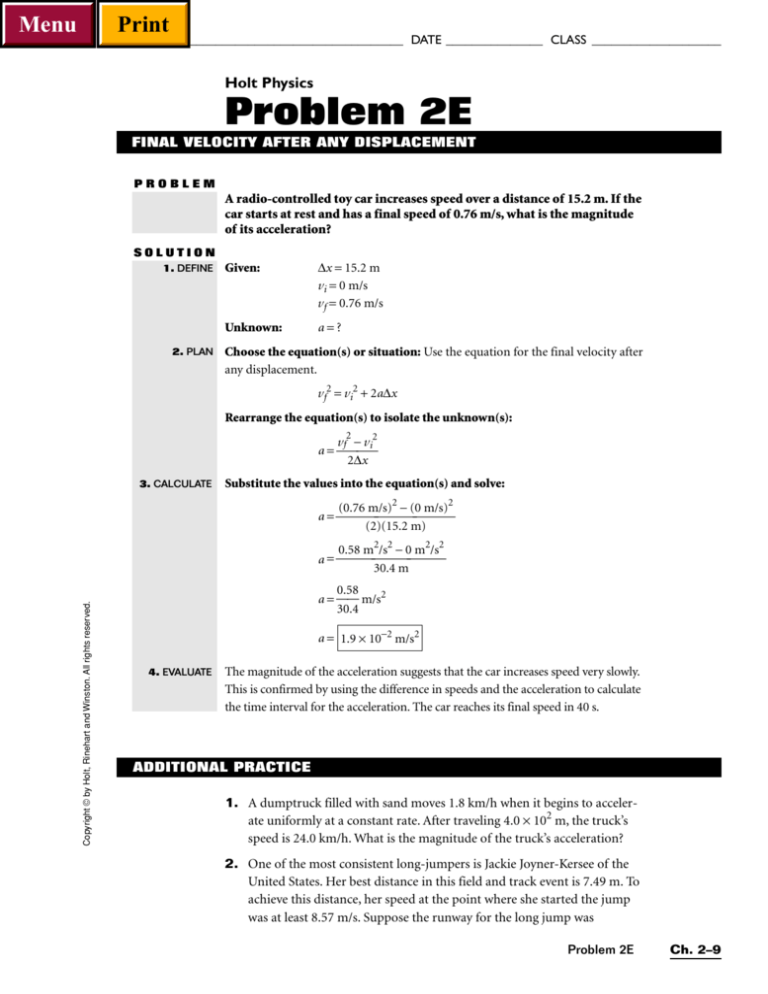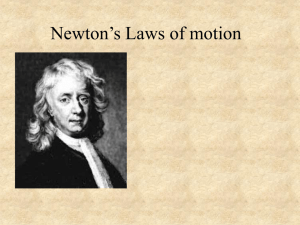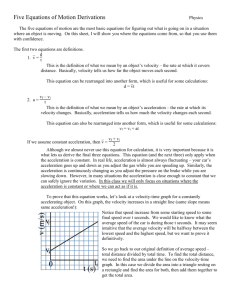
Menu
Print
NAME ______________________________________ DATE _______________ CLASS ____________________
Holt Physics
Problem 2E
FINAL VELOCITY AFTER ANY DISPLACEMENT
PROBLEM
A radio-controlled toy car increases speed over a distance of 15.2 m. If the
car starts at rest and has a final speed of 0.76 m/s, what is the magnitude
of its acceleration?
SOLUTION
1. DEFINE
2. PLAN
Given:
∆x = 15.2 m
vi = 0 m/s
vf = 0.76 m/s
Unknown:
a=?
Choose the equation(s) or situation: Use the equation for the final velocity after
any displacement.
vf2 = vi2 + 2a∆x
Rearrange the equation(s) to isolate the unknown(s):
2
vf − vi2
a =
2∆x
3. CALCULATE
Substitute the values into the equation(s) and solve:
(0.76 m/s)2 − (0 m/s)2
a =
(2)(15.2 m)
Copyright © by Holt, Rinehart and Winston. All rights reserved.
0.58 m2/s2 − 0 m2/s2
=
a
30.4 m
0.58
a = m/s2
30.4
a = 1.9 × 10−2 m/s2
4. EVALUATE
The magnitude of the acceleration suggests that the car increases speed very slowly.
This is confirmed by using the difference in speeds and the acceleration to calculate
the time interval for the acceleration. The car reaches its final speed in 40 s.
ADDITIONAL PRACTICE
1. A dumptruck filled with sand moves 1.8 km/h when it begins to accelerate uniformly at a constant rate. After traveling 4.0 × 102 m, the truck’s
speed is 24.0 km/h. What is the magnitude of the truck’s acceleration?
2. One of the most consistent long-jumpers is Jackie Joyner-Kersee of the
United States. Her best distance in this field and track event is 7.49 m. To
achieve this distance, her speed at the point where she started the jump
was at least 8.57 m/s. Suppose the runway for the long jump was
Problem 2E
Ch. 2–9
Menu
Print
NAME ______________________________________ DATE _______________ CLASS ____________________
19.53 m, and that Joyner-Kersee’s initial speed was 0 m/s. What was
the magnitude of her acceleration if it was uniform acceleration?
3. Although ungraceful on land, walruses are fine swimmers. They normally swim at 7 km/h, and for short periods of time are capable of
reaching speeds of nearly 35 km/h. Suppose a walrus accelerates from
7.0 km/h to 34.5 km/h over a distance of 95 m. What would be the
magnitude of the walrus’s uniform acceleration?
4. Floyd Beattie set an unofficial speed record for a unicycle in 1986. He
rode the unicycle through a 2.00 × 102 m speed trap, along which his
speed was measured as being between 9.78 m/s and 10.22 m/s. Suppose
that Beattie had accelerated at a constant rate along the speed trap, so
that his initial speed was 9.78 m/s and his final speed was 10.22 m/s.
What would the magnitude of his acceleration have been?
5. A fighter jet lands on an aircraft carrier’s flight deck. Although the deck
is 300 m long, most of the jet’s acceleration occurs within a distance of
42.0 m. If the jet’s velocity is reduced uniformly from +153.0 km/h to
0 km/h as it moves through 42.0 m, what is the jet’s acceleration?
6. Most hummingbirds can fly with speeds of nearly 50.0 km/h. Suppose
a hummingbird flying with a velocity of 50.0 km/h in the forward direction accelerates uniformly at 9.20 m/s2 in the backward direction until
it comes to a hovering stop. What is the hummingbird’s displacement?
7. A thoroughbred racehorse accelerates uniformly at 7.56 m/s2, reaching
its final speed after running 19.0 m. If the horse starts at rest, what is its
final speed?
9. A dog runs with an initial velocity of 1.50 m/s to the right on a waxed
floor. It slides to a final velocity of 0.30 m/s to the right with a uniform
acceleration of 0.35 m/s2 to the left. What is the dog’s displacement?
10. A hippopotamus can run up to 30 km/h, or 8.33 m/s. Suppose a hippopotamus uniformly accelerates 0.678 m/s2 until it reaches a top
speed of 8.33 m/s. If the hippopotamus has run 46.3 m, what is its initial speed?
Ch. 2–10
Holt Physics Problem Bank
Copyright © by Holt, Rinehart and Winston. All rights reserved.
8. A soccer ball moving with an initial speed of 1.8 m/s is kicked with a
uniform acceleration of 6.1 m/s2, so that the ball’s new speed is 9.4 m/s.
How far has the soccer ball moved?
Menu
Print
Givens
Solutions
9. vi = 0 m/s
vf = 72.0 m/s north
a = 1.60 m/s2 north
∆t = 45.0 s
vf − vi 72.0 m/s − 0 m/s
a. ∆t = =
= 45.0 s
a
1.60 m/s2
1
1
b. ∆x = vi∆t + a∆t2 = (0 m/s)(45.0 s) + (1.60 m/s2)(45.0 s)2 = 0 m + 1620 m
2
2
∆x = 1.62 km
10. vi = +4.42 m/s
vf = 0 m/s
a = −0.75 m/s2
∆t = 5.9 s
vf − vi 0 m/s − 4.42 m/s
−4.42 m/s
a. ∆t = =
= 2 = 5.9 s
−0.75 m/s
a
−0.75 m/s2
1
1
b. ∆x = vi∆t + a∆t2 = (4.42 m/s)(5.9 s) + (−0.75 m/s2)(5.9 s)2
2
2
∆x = 26 m − 13 m = 13 m
Additional Practice 2E
1. vi = 1.8 km/h
vf = 24.0 km/h
∆x = 4.0 × 102 m
1 h 2 103 m 2
[(24.0 km/h)2 − (1.8 km/h)2]
1 km
3600 s
a = =
2
(2)(4.0 × 10 m)
2∆x
vf2 − vi2
1 h 2 103 m 2
(576 km2/h2 − 3.2 km2/h2)
3600 s
1 km
a =
8.0 × 102 m
1 h 2 103 m 2
(573 km2/h2)
3600 s
1 km
a =
= 5.5 × 10−2 m/s2
8.0 × 102 m
2. vf = 0 m/s
vf = 8.57 m/s
vf2 − vi2
73.4 m2/s2
(8.57 m/s)2 − (0 m/s)2
a = = = = 1.88 m/s2
2∆x
39.06 m
(2)(19.53 m)
3. vi = 7.0 km/h
vf = 34.5 km/h
∆x = 95 m
1 h 2 103 m 2
[(34.5 km/h)2 − (7.0 km/h)2]
1 km
3600 s
a = =
(2)(95
m)
2∆x
vf2 − vi2
1 h 2 103 m 2
(1190 km2/h2 − 49 km2/h2)
3600 s
1 km
a =
190 m
1 h 2 103 m 2
(1140 km2/h2)
3600 s
1 km
a = = 0.46 m/s2
190 m
4. ∆x = 2.00 × 102 m
vi = 9.78 m/s
V
vf = 10.22 m/s
V Ch. 2–6
vf2 − vi2
(10.22 m/s)2 − (9.78 m/s)2
104.4 m2/s2 − 95.6 m2/s2
=
=
a=
2
2∆x
(2)(2.00 × 10 m)
4.00 × 102 m
8.8 m2/s2
a =
= 2.2 × 10−2 m/s2
4.00 × 102 m
Holt Physics Solution Manual
Copyright © Holt, Rinehart and Winston. All rights reserved.
∆x = 19.53 m
Menu
Print
Givens
5. ∆x = +42.0 m
vi = +153.0 km/h
vf = 0 km/h
Solutions
1 h 2 103 m 2
2
2
[(0
km/h)
−
(153.0
km/h)
]
3600 s
1 km
vf2 − vi2
a =
=
(2) (42.0 m)
2∆x
1 h 2 103 m 2
−(2.34 × 104 km2/h2)
3600 s
1 km
a = = −21.5 m/s2
(84.0 m)
6. vi = 50.0 km/h forward
= +50.0 km/h
vf = 0 km/h
a = 9.20 m/s2 backward
= −9.20 m/s2
1 h 2 103 m 2
[(0 km/h)2 − (50.0 km/h)2]
3600 s
1 km
∆x = =
2a
(2)(−9.20 m/s2)
vf2 − vi2
1 h 2 103 m 2
−(2.50 × 103 km2/h2)
3600 s
1 km
∆x =
2
−18.4 m/s
∆x = 10.5 m = 10.5 m forward
7. a = 7.56 m/s2
∆x = 19.0 m
vi = 0 m/s
8. vi = 1.8 m/s
vf = 9.4 m/s
a = 6.1 m/s2
9. vi = 1.50 m/s to the right
= +1.50 m/s
Copyright © Holt, Rinehart and Winston. All rights reserved.
vf = 0.30 m/s to the right
= +0.30 m/s
a = 0.35 m/s2 to the left
= −0.35 m/s2
10. a = 0.678 m/s2
vf = 8.33 m/s
∆x = 46.3 m
vi2+
m/s
)2
+(2)
vf = 2a∆
x = (0
(7
.5
6m
/s
2)(1
9.
0m
)
vf = 28
s2 = ±16.9 m/s = 16.9 m/s
7m
2/
vf2 − vi2
88 m2/s2 − 3.2 m2/s2
(9.4 m/s)2 − (1.8 m/s)2
∆x = =
=
2
2a
(2)(6.1 m/s )
(2)(6.1 m/s2)
85 m2/s2
∆x =
= 7.0 m
(2)(6.1 m/s2)
vf2 − vi2
(0.30 m/s)2 − (1.50 m/s)2
∆x = =
(2)(−0.35 m/s2)
2a
9.0 × 10−2 m2/s2 − 2.25 m2/s2
∆x =
−0.70 m/s2
−2.16 m2/s2
= +3.1 m = 3.1 m to the right
∆x =
−0.70 m/s2
m/s
vi = vf2−
2a∆
x = (8
.3
3m
/s
)2−(2)
(0
.6
78
2)(4
6.
3m
)
vi = 69
m2/
s2
−62.
s2 = 6.
s2 = ±2.6 m/s = 2.6 m/s
.4
8m
2/
6m
2/
Additional Practice 2F
1. vi = 0 m/s
vf = 49.5 m/s downward
= 49.5 m/s
a = −9.81 m/s2
∆tot = −448 m
(−49.5 m/s)2 − (0 m/s)2
vf2 − vi2
2450 m2/s2
= −125 m
∆xi = =
=
(2)(−9.81 m/s2)
2a
(2)(−9.81 m/s2)
∆x2 = ∆xtot − ∆x1 = (−448 m) − (−125 m) = −323 m
distance from net to ground = magnitude ∆x2 = 323 m
Section Five—Problem Bank
V
V Ch. 2–7









